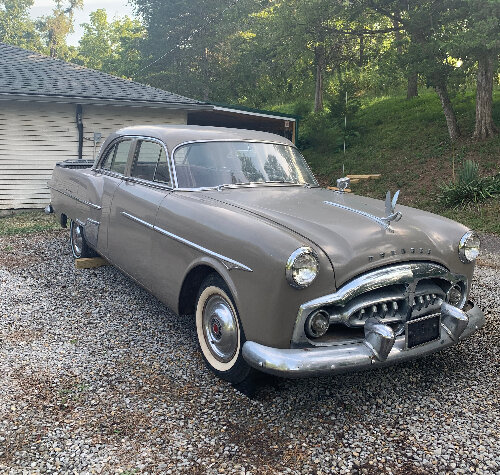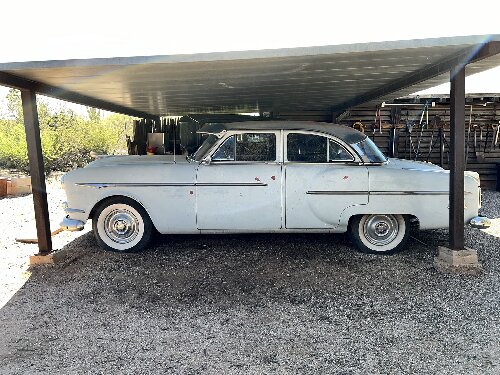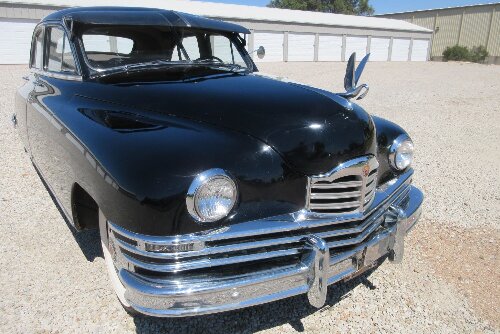|
Re: Frames by A. O. Smith
|
||||
|---|---|---|---|---|
|
Home away from home

|
When I was a kid, growing up in St. Louis in the late-1950s, we'd ride our bikes to the huge Chevrolet plant in mid September to peek through the fabric draped fencing, hoping to get a look at the upcoming model cars, Corvettes and trucks. Lots of times, there'd be rail cars with A.O.Smith frames on sidings, blocking our view. I thought it odd because all I knew of the company were the water heaters sold by my father's plumbing supply business. But, later on I'd find out that they made many things including my 1967 Corvette's body, assembled (including finished interior) in their Iona, Michigan factory, with an "A" in the vehicle number to differentiate it from the St. Louis assembled bodies which had an "S." GM contracted with AOSmith to build approximately forty percent of Corvette bodies to keep up with demand for the 1965-67 Sting Ray models. The AOSmith bodies would be stored in the basement of the Corvette plant for seamless integration with the bodies produced locally, all of them on AOSmith frames.
Posted on: 2017/4/8 13:22
|
|||
|
||||
|
Re: Frames by A. O. Smith
|
||||
|---|---|---|---|---|
|
Home away from home

|
When I was a kid, growing up in St. Louis in the late-1950s, we'd ride our bikes to the huge Chevrolet plant in mid September to peek through the fabric draped fencing, hoping to get a look at the upcoming model cars, Corvettes and trucks. Lots of times, there'd be rail cars with A.O.Smith frames on sidings, blocking our view. I thought it odd because all I knew of the company were the water heaters sold by my father's plumbing supply business. But, later on I'd find out that they made many things including my 1967 Corvette's body, assembled (including finished interior) in their Iona, Michigan factory, with an "A" in the vehicle number to differentiate it from the St. Louis assembled bodies which had an "S." GM contracted with AOSmith to build approximately forty percent of Corvette bodies to keep up with demand for the 1965-67 Sting Ray models. The AOSmith bodies would be stored in the basement of the Corvette plant for seamless integration with the bodies produced locally, all of them on AOSmith frames.
Posted on: 2017/4/8 13:22
|
|||
|
||||
|
Three wheeled Series 22?
|
||||
|---|---|---|---|---|
|
Home away from home

|
For those of you who are Packard Club members and get the monthly Cormorant News Bulletin, the photo on the back page (cited from the Erwin Weiss collection....so I won't try and post it without permission) shows two men with a 22nd Series Convertible. What is striking is that the car appears to be standing level with the right front wheel removed.
In the current concern over Fake News and Photoshopped pictures, my curiousity is getting the better of me. Without the wheel and tire, the brake drum doesn't appear to be hanging as you might expect, nor is the car tipping down. Considering the massive weight of the engine and transmission on the front end, why is this? The photo caption mentions the "inherent stability" of the 22/23 Series cars, but somehow I cannot believe that my 23rd would do the same if I removed a front wheel. Perhaps the man in the hat is unusually strong and he's pushing down on the rear end to compensate for the 900 pounds of engine and transmission. I have also heard that the pre-1951 Packards had strong and sturdy frames (even more so for the convertibles) that permitted dealers to routinely raise these cars on single pole lifts in the service bays by pushing up on the middle of the X braces on the frames. Ouch, but that was before OSHA was around to protect Packard mechanics. Perhaps this issue was a bit early to show the photo before April Fools Day. Or, can it be possible?
Posted on: 2017/3/31 11:22
|
|||
|
||||
|
Re: Men bet their lives on it - the Packard-built Merlin V-12
|
||||
|---|---|---|---|---|
|
Home away from home

|
Another thing I noted with some amazement was that while Henry Ford declined the Merlin engine building contract in the US, his British Ford subsidiary built almost as many Merlins as Packard in Manchester. That was news to me, but I suppose they didn't have the challenges that Packard had because of the Whitworth tool building requirements.
I still think it is ironic that GM (in its North American Aviation unit) built Mustangs (P-51s) long before Ford did in 1964. And Charley Wilson did put a significant nail in Packard's coffin when they pulled some critical defense contracts at the end of the Korean conflict. The Perfect Storm of all those reasons for Packard's demise could not have been more complicated. No wonder we're still talking about it sixty years later. But remember, 72 years ago men bet their lives on it.
Posted on: 2017/3/29 9:42
|
|||
|
||||
|
Re: Help with value of Packard
|
||||
|---|---|---|---|---|
|
Home away from home

|
Neil's book (a valuable resource for anyone with a post-war 22-23 series car) tells me that the instrument cluster appears to be from a 23 series car, and possibly not this 22nd car. The 22nd cars did not have "Packard" signage between the speedometer and the clock but the 1949-50s cars like mine do. This raises the possibility that the cluster, including the low mileage odometer, might be from another car. Further investigation to protect that claim might be in order.
Otherwise, from the pictures shown, this appears to be a very nice car. Learn the differences between the two series and you'll appreciate it, as it stands. Just be careful about the mileage claims...they might be right but something appears to have been changed thereabouts.
Posted on: 2017/3/27 7:18
|
|||
|
||||
|
Re: Conner ave plant
|
||||
|---|---|---|---|---|
|
Home away from home

|
Wasn't Conner (either under Briggs or Chrysler) also producing the last of the "Step-down" bodies for Hudson? There's some mention in the Crestline Hudson history book and photos showing trucks transporting incompletely trimmed Hudson bodies to the Hudson plant (the one GM bought at bargain basement rates and where the 1956 Cadillacs were produced following the GM renovation.
In my opinion, the first big error in the Packard demise saga occurred when Briggs was awarded the contract to build Packard's bodies in the early 1940s. Soon thereafter, Briggs asked for a price increase and things would never be the same on East Grand again. The war production push merely masked the odor of a very bad deal until the seller's market dissipated later in the decade. Multi-stories or not, I suspect most of us would have supported Packard-built bodies continuing to come out of the recently re-tooled and renovated dual line East Grand plant. Bad advice be damned, hindsight is often twenty twenty. One other thing that several of you with Packard production order documentation might answer; both of my 1956 In-transit/bill of lading show notations of "WAS sales". Does anyone know what that might mean? This also appears on other people's documents for their cars.
Posted on: 2017/3/24 13:05
|
|||
|
||||
|
Re: Battery change
|
||||
|---|---|---|---|---|
|
Home away from home

|
For those of you with a Tractor Supply Company outlet nearby, their six volt Exide labeled battey fits a 22-23 Series tray and hold down nicely. We now have these batteries in my 1950 and a friend's 1948, both doing nicely for about a $100 each. I keep a fully charged Optima Red Top 6 volt in the trunk for just in case I need a boost or replacement. For those of you who have never ventured inside a TSC store, there must be something for everyone inside. They not only have batteries and stuff to keep tractors alive, they have a wide range of vet supplies and pet foods. It will be the place for me to go next time I need goat de-workers or hog troughs.
Posted on: 2017/3/24 12:37
|
|||
|
||||
|
T/L Brake light switch
|
||||
|---|---|---|---|---|
|
Home away from home

|
As sure as the sun rises, with a show that I really want to drive a Packard to coming up this Saturday, all three Packards have decided to have issues at the same time. I had done my due diligence by replacing my BTV unit last month in the Esquire, and all seemed normal until folks started telling me that the brake lights were staying on. Having had a similar problem several years ago, I replaced the switch with a NOS (still in an unopened S/P package) that came with the car. Problem seemed solved. Until I put in the rebuilt BTV from our favorite supplier, all seemed well until last week when the brake lights started staying on and the T/L stopped compensating because of the circuits.
My first question is how long do these switches tend to last under infrequent or light use? At the current price, I'd rather not order a new one without ruling out something else. Because of its placement, I did not disturb the switch knowingly when I did the BTV work. I did do a bench bleed and bled the system afterwards, and my son wondered if an air bubble left behind might cause the switch to malfunction. I have bled the system twice since, to no avail. The new BTV seems to be working fine brake-wise, but could something be trapping fluid under pressure, causing the switch to close? The wheels turn normally, so I don't see how the system could be trapping fluid. The brake lights will come on anytime the battery is connected. A spare switch (the old one I removed) also closes the circuit even though it's not connected to the hydraulic system. Connecting either causes the lights to shine. Does the hole in a switch need to be pre-filled with DOT 3 before installing in the fitting, or does normal brake line pressure do that? Getting to the Palmetto show involves about 60 miles of interstate travel, and I don't want to do it with brake lights blazing. Alternatively, driving the 1950 with overdrive would work except for doing it without the seat belts that have yet to arrive. I hate the thought of showing up in a newer Corvette or VW, but may have to do so until the Packard stars come into alignment. The opportunity comes but once a year, so maybe I'll just have to settle by showing off Packard pictures on an iPhone.
Posted on: 2017/3/19 14:22
|
|||
|
||||
|
Re: Driver's door window removal
|
||||
|---|---|---|---|---|
|
Home away from home

|
On a related note, how many of you have cracked the glass in your Packard by an unintended slam of the door? By now, it has happened a third time in my three cars, so I'm quickly learning how easily it can happen.
A few weeks ago, at a Packard board meeting, I mentioned my glass plight and got all sorts of commiserating comments from fellow club members. Our club president, who has had family Packards since the mid-1940s said that it happened all the time in the 40-50s, and not just to their Packards. He noted that such accidents were rare when the glass was fully up and tight. It happened more frequently when the window was halfway down, and sometimes when fully lowered. From hard experience, he and family learned that a gentle closing was the surest way to avoid glass replacement, but a gust of wind or a stranger at a car show could easily cause it to happen again. He said that lots of cars in the 40-50's had similar fates, probably caused by loosening window regulator hardware striking the glass when it was down. Driver's doors, subject to much more regulator wear, had looser regulators, hence they broke more frequently than other glass. Makes sense to me. All three of mine had driver's side glass damage done. One sedan and two hardtops. One has already been replaced, and while the glass was being cut, I had a second cut, just in case for the second 56 hardtop. Not a month later, someone slammed the door on that car at a car show, and history was repeated. The 1950 sedan was done by me, with no excuses made. The first hardtop now has a bit of padding wrapped around the regulator arm, to do what I can to prevent yet another cracking. So far, so good, but I am careful and have warned others about thoughtless door closing. Seems like only the Packards at my house are having these issues, but we're being mindful with the rest. Thank goodness Packard used only flat laminated glass that can be cut locally.
Posted on: 2017/3/11 9:13
|
|||
|
||||








